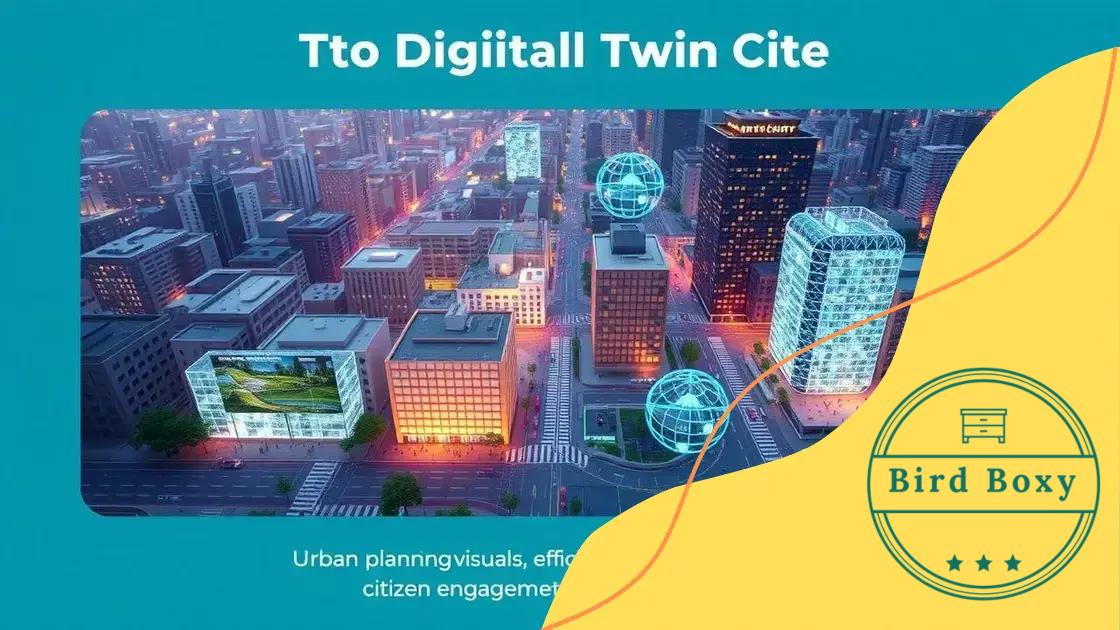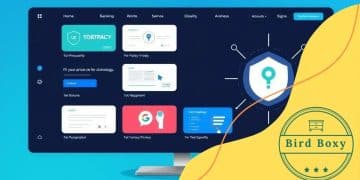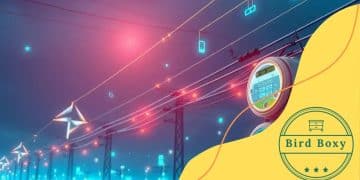Digital twin cities projects transforming urban planning

Digital twin cities utilize virtual models to optimize urban planning and management, addressing challenges like data privacy while enhancing sustainability, resource efficiency, and citizen engagement.
Digital twin cities projects are revolutionizing how we think about urban environments. Imagine a virtual replica of your city that helps planners make real-time decisions. Intrigued? Let’s explore how this technology is shaping our urban landscapes.
Understanding digital twin cities: An overview
Digital twin cities are innovative models that create a virtual representation of urban areas. This technology helps in simulating and analyzing city dynamics. By leveraging real-time data, planners can make smarter decisions for their communities.
What is a Digital Twin City?
A digital twin city is a digital replica of a physical city. It includes various elements like buildings, roads, and even transportation systems. This technology enables users to monitor and manage resources effectively, enhancing urban planning.
It allows for modeling different scenarios. For example, city planners can observe how traffic changes during peak hours. This real-time analysis leads to improved policies and services for residents.
Key Features of Digital Twin Cities
- Real-time monitoring: Data is constantly updated to reflect current city conditions.
- Scenario simulation: Allows users to test different planning scenarios without real-world consequences.
- Resource optimization: Helps in making better use of city resources, like energy and water.
- Enhanced collaboration: Facilitates communication among stakeholders, including government, businesses, and citizens.
By implementing digital twin technology, cities can address challenges such as traffic congestion and energy consumption. This results in a more sustainable urban environment. Collaboration among various sectors is key to maximizing the benefits of this technology.
Moreover, digital twin cities can improve citizen engagement. Residents can understand how new projects will affect their lives through visual representations. This openness fosters a sense of community, allowing citizens to participate in the decision-making process.
In conclusion, understanding digital twin cities is crucial for modern urban planning. They offer insights that lead to better outcomes for communities. Embracing this technology can shape the future of urban areas around the world.
Key technologies behind digital twin projects
Key technologies drive the success of digital twin projects. These tools create virtual replicas of cities and facilitate better decision-making. With the right technology, cities can optimize their operations and improve residents’ quality of life.
Internet of Things (IoT)
The Internet of Things plays a crucial role in digital twins. IoT devices collect data from the physical environment, such as traffic patterns and energy use. This information is then used to update the digital model in real time.
Artificial Intelligence (AI)
Artificial Intelligence enhances the capabilities of digital twins. AI algorithms analyze the data collected from the IoT devices. They identify trends and suggest improvements for city planning. For example, AI can predict traffic congestion and recommend adjustments to reduce bottlenecks.
- Smart sensors: These devices gather data on air quality, temperature, and other environmental factors.
- Data analytics: Analyzing gathered data helps in finding patterns that inform future city policies.
- Cloud computing: Provides the necessary infrastructure to store and process massive amounts of data from numerous sources.
- Visualization tools: Help stakeholders better understand the data through interactive models and visual aids.
Combining these technologies allows cities to create comprehensive and interactive digital models. Residents can see how changes affect their environment. This contributes to an informed public that can engage in discussions about their city’s future.
As digital twin projects evolve, so does the technology behind them. Continuous advancements in IoT, AI, and data analytics benefit urban planning. They bring precision and efficiency to city management, making urban areas smarter and more responsive to change.
Investing in these key technologies is essential for any city interested in becoming a digital twin. Each element works together to create an integrated system that can effectively manage resources and improve urban life. Understanding and adopting these technologies can significantly enhance a city’s future.
Benefits of implementing digital twin cities

Implementing digital twin cities offers numerous benefits that enhance urban living. These advantages transform the way cities operate and serve their residents, making life more efficient and sustainable.
Improved Urban Planning
Digital twin technologies enable planners to visualize the impact of their decisions. By using real-time data, they can see how proposed projects will play out before they are built. This reduces the likelihood of costly mistakes.
Enhanced Resource Management
Cities can better manage resources like water and energy through digital twins. Sensors collect data on usage patterns, allowing for proactive measures to reduce waste. Efficient resource management leads to cost savings and a lower environmental footprint.
- Predictive maintenance: Identifying issues before they affect services.
- Energy efficiency: Optimizing energy consumption based on demand.
- Water management: Monitoring usage and preventing leaks.
- Traffic optimization: Adjusting traffic signals to reduce congestion.
These approaches create a more responsive city that can adapt to changing needs. They also support sustainability goals, making cities cleaner and greener.
Moreover, digital twins can drive citizen engagement. Residents can access information about city projects or changes. This transparency fosters trust and allows citizens to voice concerns or suggestions.
By improving communication between government and residents, digital twin cities cultivate a stronger sense of community. When people feel involved, they are more likely to support initiatives aimed at improving their environment.
In addition, digital twin cities can enhance disaster response. By simulating emergency scenarios, cities can develop robust plans. This preparedness minimizes risks during real emergencies, ensuring safety for all residents.
Case studies of successful digital twin cities
Examining case studies of successful digital twin cities reveals valuable insights into their practical applications. These examples showcase how cities worldwide use digital twin technology to improve urban living and solve pressing issues.
Singapore
Singapore is a leading example of a digital twin city. Its Virtual Singapore initiative creates a 3D digital model of the entire city. This model aids in planning and management. Authorities can analyze traffic flow, energy consumption, and more.
- Real-time simulations: The digital twin helps officials simulate different urban scenarios, allowing them to make informed decisions.
- Enhanced sustainability: By monitoring resources, the city can reduce waste and energy usage effectively.
- Public engagement: Residents can access the model and provide feedback on urban projects.
Such engagement fosters a greater sense of community and transparency.
Dubai
Dubai has also embraced the concept of digital twins with its Smart Dubai initiative. The city leverages data from its digital twin to optimize services and enhance the quality of life for residents. This project includes a smart city platform that integrates various city services.
For instance, the city can track energy consumption in real time. By analyzing this data, officials can create strategies to increase efficiency. Also, the virtual model allows for better emergency response planning, ensuring safety for all residents.
Barcelona
Barcelona uses a digital twin to improve urban mobility. The model analyzes public transport usage and traffic flows. This insight helps city planners optimize routes and decrease congestion.
- Data-driven decisions: Transport authorities can make real-time adjustments to improve public transit efficiency.
- Citizen feedback: The city involves residents in the planning process, leading to user-friendly solutions.
- Environmental benefits: Reduced congestion results in lower emissions, supporting environmental goals.
By looking at these cities, we can see how effective digital twin technology can be in addressing urban challenges. Each case study illustrates unique applications that lead to improved services and enhanced quality of life.
Challenges and future of digital twin cities
Exploring the challenges and future of digital twin cities reveals important insights for urban development. While these technologies offer great potential, several obstacles must be addressed for successful implementation.
Data Privacy and Security
One major challenge is ensuring data privacy and security. Digital twins rely on collecting vast amounts of information about city infrastructure and residents. Safeguarding this data from breaches is crucial to maintain public trust.
Integration of Technologies
Another issue is the integration of various technologies. Different systems must work together seamlessly to create an effective digital twin. This requires collaboration among stakeholders, including tech companies and government agencies.
- Interoperability: Ensuring that various systems communicate effectively.
- Standardization: Developing common standards across technologies can be difficult.
- Funding: Securing investment for technology upgrades and infrastructure is essential.
As cities adopt digital twin technology, overcoming these challenges is vital for optimal performance. The collaboration between technical experts and city planners will drive improvements and efficiency.
Future Prospects
The future of digital twin cities looks promising as technology continues to advance. Emerging technologies, such as artificial intelligence and machine learning, will enhance predictive analytics. Cities can anticipate challenges and make proactive adjustments.
For example, smart traffic management systems can reduce congestion before it becomes an issue. These innovations not only improve the urban experience but also help achieve sustainability goals.
As cities evolve, the focus will expand to include social aspects. Engaging residents in planning processes will be crucial. This input will lead to solutions that cater not only to efficiency but also to citizen needs.
In summary, addressing challenges like data security and technology integration will be key. As digital twin cities develop, they hold the potential to transform urban living in numerous ways, making cities smarter and more responsive.
FAQ – Frequently Asked Questions about Digital Twin Cities
What is a digital twin city?
A digital twin city is a virtual model that simulates the physical city, helping planners visualize data and improve urban decision-making.
What are the main challenges of implementing digital twin technology?
Key challenges include data privacy concerns, integrating various technologies, and securing adequate funding for infrastructure.
How can citizens engage with digital twin projects?
Citizens can participate by providing feedback on urban projects and using digital tools to access city information, fostering greater community involvement.
What is the future of digital twin cities?
The future looks promising with advanced technologies like AI enhancing predictive analytics, leading to smarter and more sustainable urban environments.






